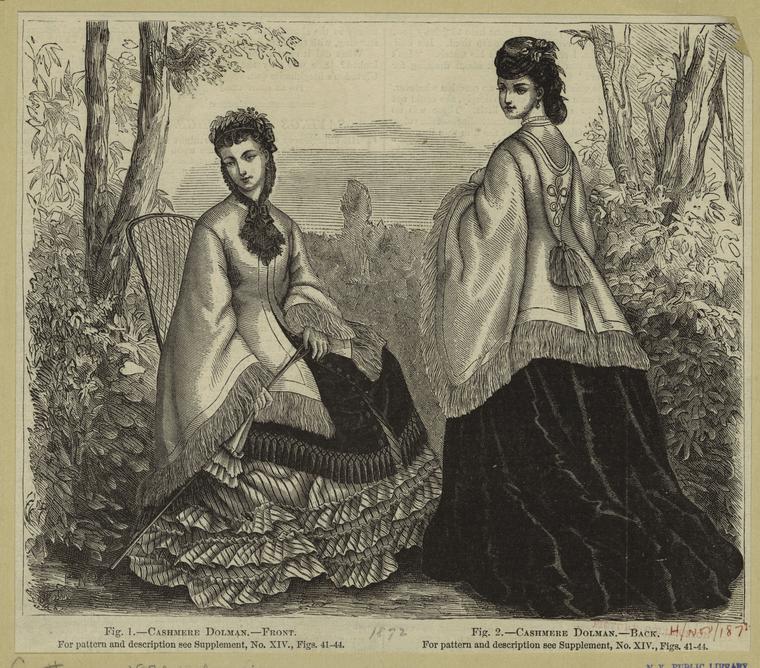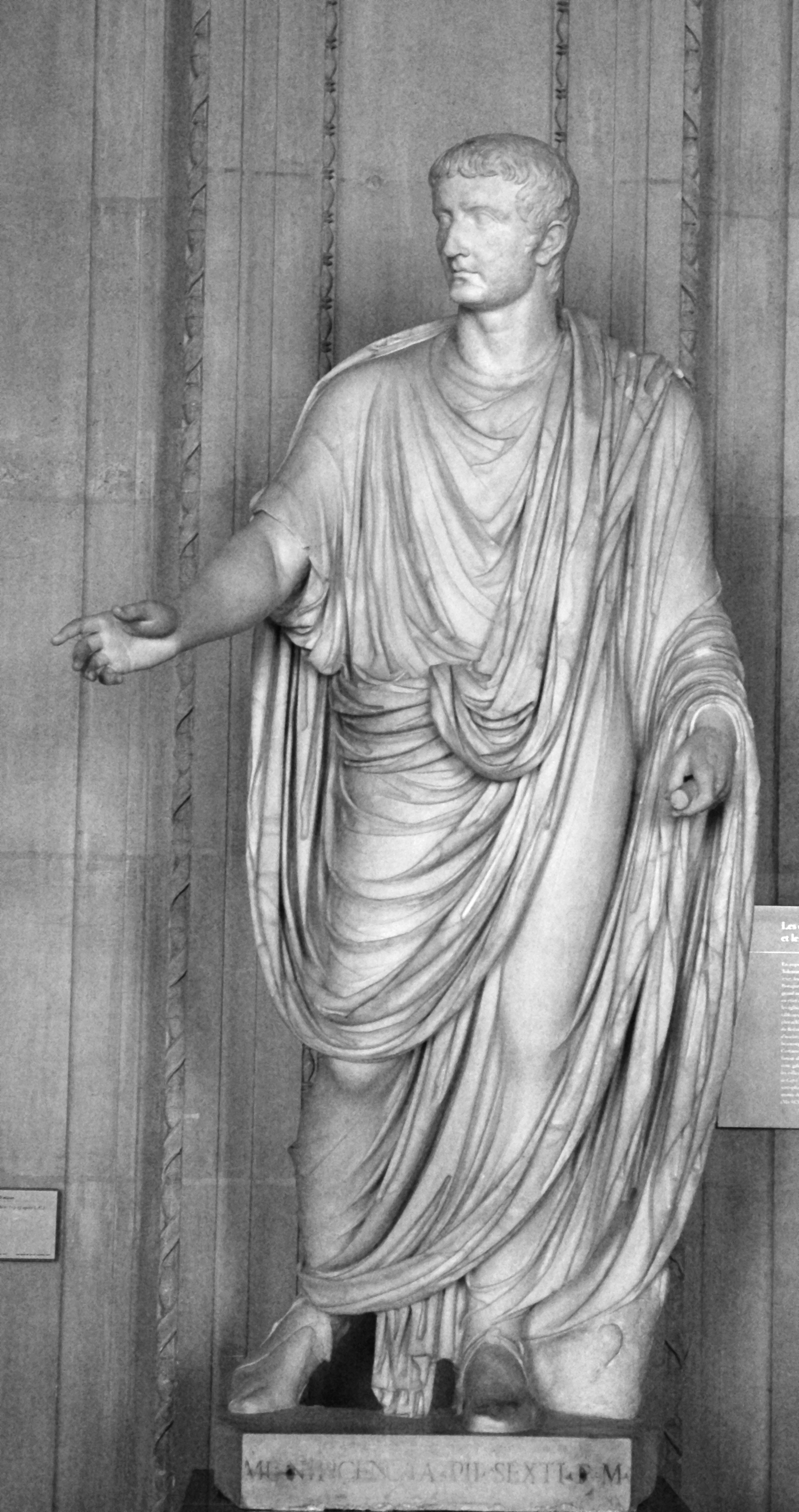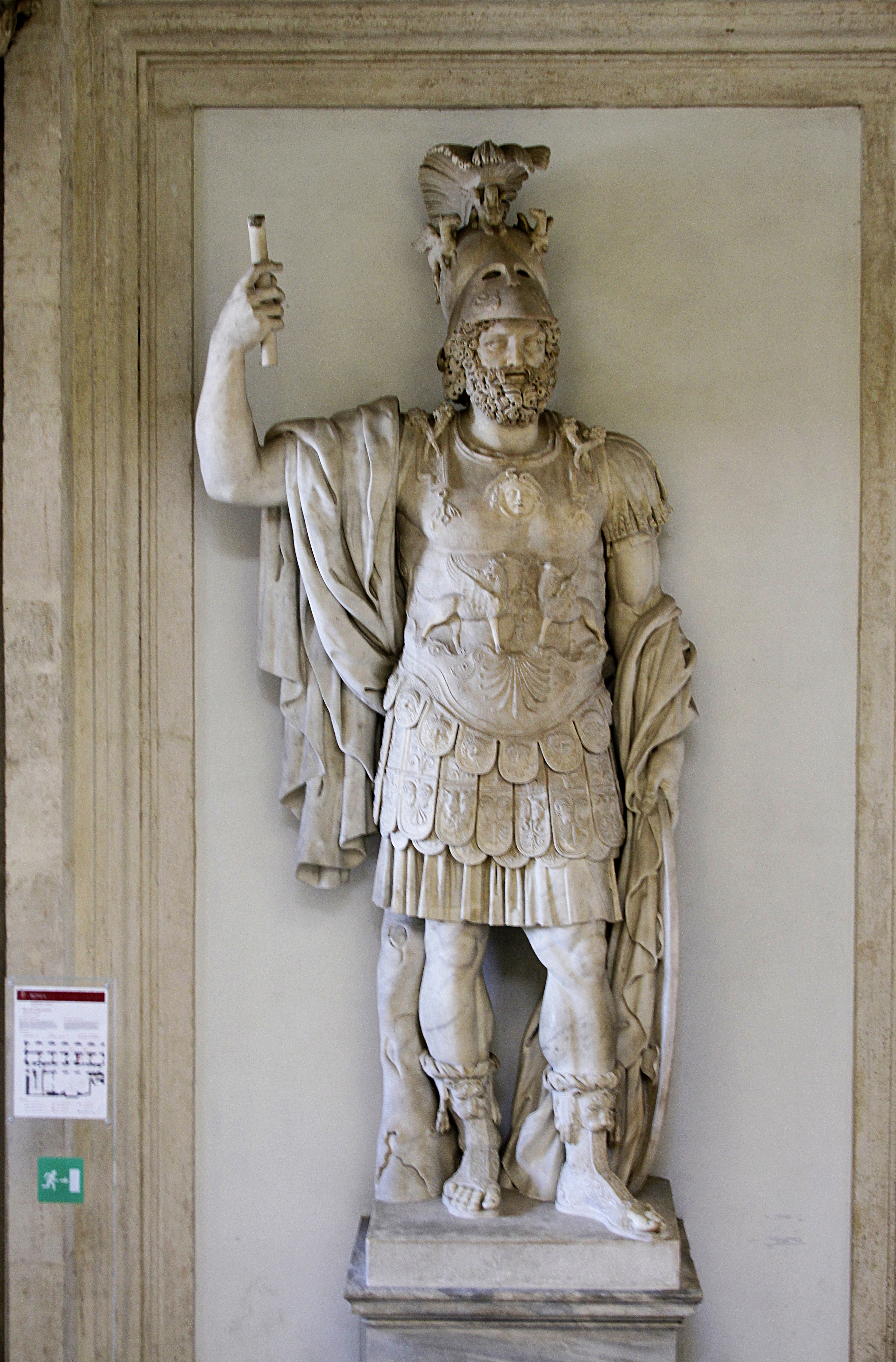|
Palla (garment)
The ''palla'' was an elegant cloak or mantle that was wrapped around the body. It was worn outside the house by (affluent) Roman women. It was a luxurious version of the Roman men's ''pallium''. The ''palla'' was a traditional ancient Roman mantle worn by women, fastened by brooches. The shape was rectangular instead of semi-circular, as with the traditional toga. The garment dates to the 3rd century BC, but the type of dress must be much older. In Latin literature, the term ''palla'' is used ambiguously. It can denote not only a cloak, but also a foot-length sleeveless dress with straps (or a brooch) worn directly on the skin. The second is a common dress form in the entire Mediterranean world. In a Greek cultural context, this is called ''peplos''. In a Roman cultural context, if worn by a Roman matron, it also takes the name ''stola''. See also * Clothing in ancient Rome Clothing in ancient Rome generally comprised a short-sleeved or sleeveless, knee-length tunic for m ... [...More Info...] [...Related Items...] OR: [Wikipedia] [Google] [Baidu] |
Livia Drusila (15708884953)
Livia Drusilla (30 January 59 BC AD 29) was Roman empress from 27 BC to AD 14 as the wife of Augustus, the first Roman emperor. She was known as Julia Augusta after her formal adoption into the Julia ''gens'' in AD 14. Livia was the daughter of senator Marcus Livius Drusus Claudianus and his wife Alfidia. She married Tiberius Claudius Nero around 43 BC, and they had two sons, Tiberius and Drusus. In 38 BC, she divorced Tiberius Claudius Nero and married the political leader Octavian. The Senate granted Octavian the title ''Augustus'' in 27 BC, effectively making him emperor. In her role as Roman empress, Livia served as an influential confidant to her husband and was rumored to have been responsible for the deaths of several of his relatives, including his grandson Agrippa Postumus. After Augustus died in AD 14, Tiberius was elevated, and Livia continued to exert political influence as the mother of the emperor until her death ... [...More Info...] [...Related Items...] OR: [Wikipedia] [Google] [Baidu] |
Cloak
A cloak is a type of loose garment worn over clothing, mostly but not always as outerwear for outdoor wear, which serves the same purpose as an overcoat and protects the wearer from the weather. It may form part of a uniform. People in many different societies may wear cloaks. Over time, cloak designs have changed to match fashion and available textiles. Cloaks generally fasten at the neck or over the shoulder, and vary in length from the hip to the ankle, with mid-calf being the normal length. They may have an attached hood (headgear) , hood and may cover and fasten down the front, in which case they have holes or slits for the hands to pass through. However, cloaks are almost always sleeveless. Christian clerics may wear a cappa or a cope – forms of cloak – as liturgical vestments or as part of a religious habit. Etymology The word ''cloak'' comes from Old North French ''cloque'' (Old French ''cloche'', ''cloke'') meaning "bell", from Medieval Latin ''clocca'' "travele ... [...More Info...] [...Related Items...] OR: [Wikipedia] [Google] [Baidu] |
Mantle (clothing)
__NOTOC__ A mantle (from old French ''mantel'', from ''mantellum'', the Latin">-4; we might wonder whether there's a point at which it's appropriate to talk of the beginnings of French, that is, when it wa ... ''mantel'', from ''mantellum'', the Latin term for a cloak) is a type of loose garment usually worn over indoor clothing to serve the same purpose as an overcoat. Technically, the term describes a long, loose cape-like cloak worn from the 12th to the 16th century by both sexes, although by the 19th century, it was used to describe any loose-fitting, shaped outer garment similar to a cape. For example, the dolman, a 19th-century cape-like woman's garment with partial sleeves is often described as a mantle. In English, the idiom "to take up/pick up/assume the mantle" is from the Bible, and means to take a position of authority, leadership or responsibility in a particular area, especially in the sense of carrying on for a previous figure. The most notable appearance in th ... [...More Info...] [...Related Items...] OR: [Wikipedia] [Google] [Baidu] |
Pallium (Roman Cloak)
The ''pallium'' was a Roman cloak. It was similar in form to the '' palla'', which had been worn by respectable Roman women since the mid-Republican era. It was a rectangular length of cloth, as was the ''himation'' in ancient Greece. It was usually made from wool or flax, but for the higher classes it could be made of silk with the use of gold threads and embroideries. The garment varied in fineness, colour and ornament. It could be white, purple red (''purpurea'' from murex), black, yellow, blue, pale green, etc. The ''pallium'' was originally considered to be exclusively Greek and despised by Romans, but was favoured by ordinary people, philosophers, and pedagogues. Tertullian thought it the most appropriate garment for philosophers and Christians. It is not to be confused ... [...More Info...] [...Related Items...] OR: [Wikipedia] [Google] [Baidu] |
Ancient Rome
In modern historiography, ancient Rome is the Roman people, Roman civilisation from the founding of Rome, founding of the Italian city of Rome in the 8th century BC to the Fall of the Western Roman Empire, collapse of the Western Roman Empire in the 5th century AD. It encompasses the Roman Kingdom (753–509 BC), the Roman Republic (50927 BC), and the Roman Empire (27 BC476 AD) until the fall of the western empire. Ancient Rome began as an Italic peoples, Italic settlement, traditionally dated to 753 BC, beside the River Tiber in the Italian peninsula. The settlement grew into the city and polity of Rome, and came to control its neighbours through a combination of treaties and military strength. It eventually controlled the Italian Peninsula, assimilating the Greece, Greek culture of southern Italy (Magna Graecia) and the Etruscans, Etruscan culture, and then became the dominant power in the Mediterranean region and parts of Europe. At its hei ... [...More Info...] [...Related Items...] OR: [Wikipedia] [Google] [Baidu] |
Mantle (clothing)
__NOTOC__ A mantle (from old French ''mantel'', from ''mantellum'', the Latin">-4; we might wonder whether there's a point at which it's appropriate to talk of the beginnings of French, that is, when it wa ... ''mantel'', from ''mantellum'', the Latin term for a cloak) is a type of loose garment usually worn over indoor clothing to serve the same purpose as an overcoat. Technically, the term describes a long, loose cape-like cloak worn from the 12th to the 16th century by both sexes, although by the 19th century, it was used to describe any loose-fitting, shaped outer garment similar to a cape. For example, the dolman, a 19th-century cape-like woman's garment with partial sleeves is often described as a mantle. In English, the idiom "to take up/pick up/assume the mantle" is from the Bible, and means to take a position of authority, leadership or responsibility in a particular area, especially in the sense of carrying on for a previous figure. The most notable appearance in th ... [...More Info...] [...Related Items...] OR: [Wikipedia] [Google] [Baidu] |
Brooch
A brooch (, ) is a decorative jewellery item designed to be attached to garments, often to fasten them together. It is usually made of metal, often silver or gold or some other material. Brooches are frequently decorated with enamel or with gemstones and may be solely for ornament or serve a practical function as a clothes fastener. The earliest known brooches are from the Bronze Age. As fashions in brooches changed rather quickly, they are important chronological indicators. In archaeology, ancient European brooches are usually referred to by the Latin term fibula. One example is the Tara Brooch. Ancient brooches Brooches from antiquity and before the Middle Ages are often called fibulae (singular: ''fibula''), especially in continental European contexts. British archaeologists tend to distinguish between bowed fibulae and flatter brooches, even in antiquity. They were necessary as clothes fasteners, but also often highly decorative, and important markers of social status f ... [...More Info...] [...Related Items...] OR: [Wikipedia] [Google] [Baidu] |
Toga
The toga (, ), a distinctive garment of Ancient Rome, was a roughly semicircular cloth, between in length, draped over the shoulders and around the body. It was usually woven from white wool, and was worn over a tunic. In Roman historical tradition, it is said to have been the favored dress of Romulus, Rome's founder; it was also thought to have originally been worn by both sexes, and by the citizen-military. As Roman women gradually adopted the stola, the toga was recognized as formal wear for male Roman citizens. Women found guilty of adultery and women engaged in prostitution might have provided the main exceptions to this rule.. The type of toga worn reflected a citizen's rank in the civil hierarchy. Various laws and customs restricted its use to citizens, who were required to wear it for public festivals and civic duties. From its probable beginnings as a simple, practical work-garment, the toga became more voluminous, complex, and costly, increasingly unsuited to a ... [...More Info...] [...Related Items...] OR: [Wikipedia] [Google] [Baidu] |
Peplos
A peplos () is a body-length garment established as typical attire for women in ancient Greece by , during the late Archaic Greece, Archaic and Classical Greece, Classical period. It was a long, rectangular cloth with the top edge folded down about halfway, so that what was the top of the rectangle was now draped below the waist, and the bottom of the rectangle was at the ankle. One side of the peplos could be left open, or pinned or sewn together,"Ancient Greek Dress" ''Heilbronn Timeline of Art History'', Metropolitan Museum of Art, 2000–2013. Retrieved 7 October 2013. with a type of brooch later called "fibula". In Latin and in a Roman context, it could be called a ''Palla (garment), palla''. It should not be confused with the Ionians, Ionic Chiton (garment), chiton, which was a piece of fabric folded over and sewn toget ... [...More Info...] [...Related Items...] OR: [Wikipedia] [Google] [Baidu] |
Stola
The stola () (pl. ''stolae'') was the traditional garment of Roman women, corresponding to the toga that was worn by men. It was also called ''vestis longa'' in Latin literary sources, pointing to its length. History The ''stola'' was a staple of fashion in ancient Rome spanning from the early Roman Republic until the beginning of the 2nd century CE. The garment was first identified on statues by Margarete Bieber. The first evidence of the ''stola''/''vestis longa'' dates to the 3rd century BCE, but the form of the garment is common in the Mediterranean world and so it must be much older. In Republican times, it was simply part of Roman female dress practice. In Augustan times, when it was used much less, the ''stola'' was taken up by Imperial cultural policy and was turned – like the '' vitta'' (plaited headband) – into a dress insigne of married Roman women. It may even have been a legal privilege. By this time, it was worn only by women of the social elite. At the beginni ... [...More Info...] [...Related Items...] OR: [Wikipedia] [Google] [Baidu] |
Clothing In Ancient Rome
Clothing in ancient Rome generally comprised a short-sleeved or sleeveless, knee-length tunic for men and boys, and a longer, usually sleeved tunic for women and girls. On formal occasions, adult male citizens could wear a woolen toga, draped over their tunic, and married citizen women wore a woolen mantle, known as a Palla (garment), palla, over a stola, a simple, long-sleeved, voluminous garment that modestly hung to cover the feet. Clothing, footwear and accoutrements identified gender, status, rank and social class. This was especially apparent in the distinctive, privileged official dress of Roman magistrate, magistrates, Religion in ancient Rome#Public priesthoods and religious law, priesthoods and Ancient Roman military clothing, the military. The toga was considered Rome's "Folk costume, national costume," privileged to Roman citizens but for day-to-day activities most Romans preferred more casual, practical and comfortable clothing; the tunic, in various forms, was th ... [...More Info...] [...Related Items...] OR: [Wikipedia] [Google] [Baidu] |
3rd-century BC Establishments In The Roman Republic
The 3rd century was the period from AD 201 (represented by the Roman numerals CCI) to AD 300 (CCC) in accordance with the Julian calendar. In this century, the Roman Empire saw a crisis, starting with the assassination of the Roman Emperor Severus Alexander in 235, plunging the empire into a period of economic troubles, barbarian incursions, political upheavals, civil wars, and the split of the Roman Empire through the Gallic Empire in the west and the Palmyrene Empire in the east, which all together threatened to destroy the Roman Empire in its entirety, but the reconquests of the seceded territories by Emperor Aurelian and the stabilization period under Emperor Diocletian due to the administrative strengthening of the empire caused an end to the crisis by 284. This crisis would also mark the beginning of Late Antiquity. While in North Africa, Roman rule continued with growing Christian influence, particularly in the region of Carthage. In Persia, the Parthian Empire was suc ... [...More Info...] [...Related Items...] OR: [Wikipedia] [Google] [Baidu] |








